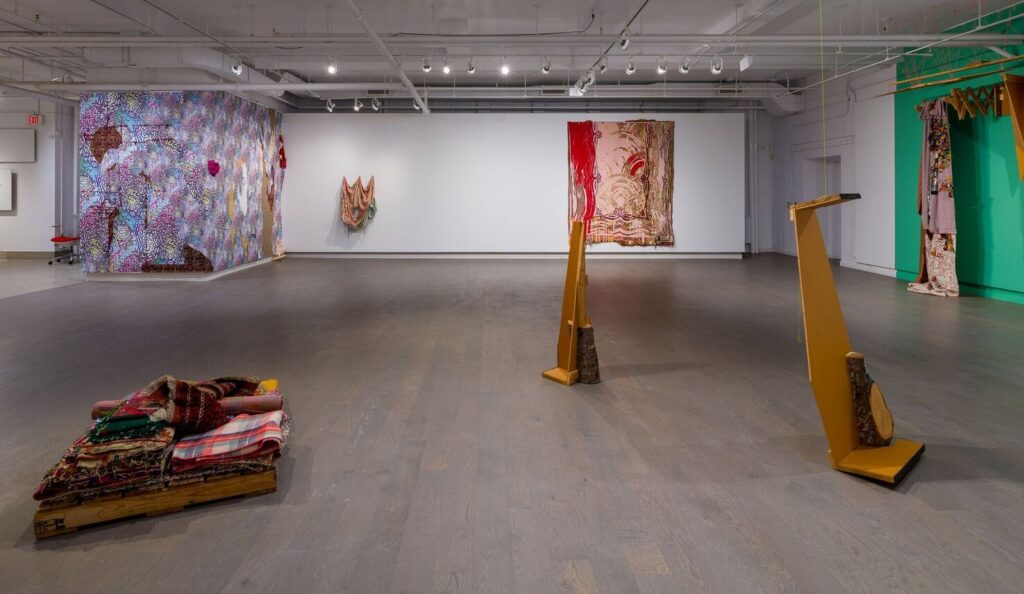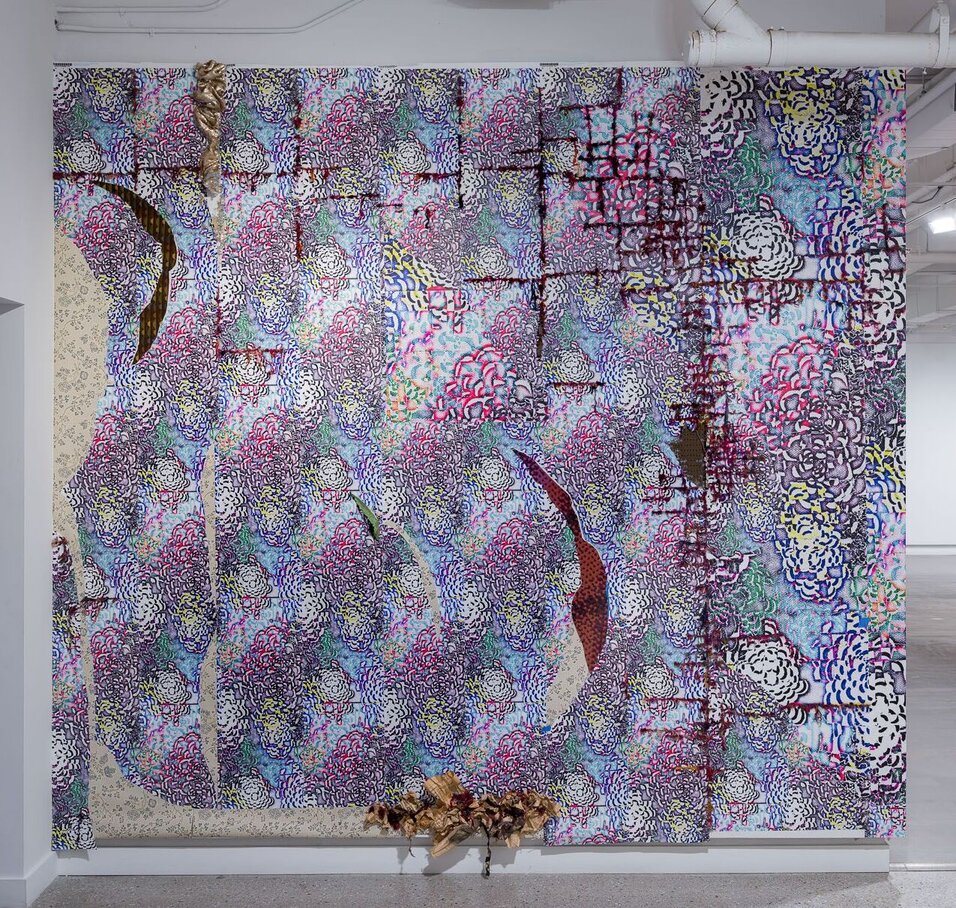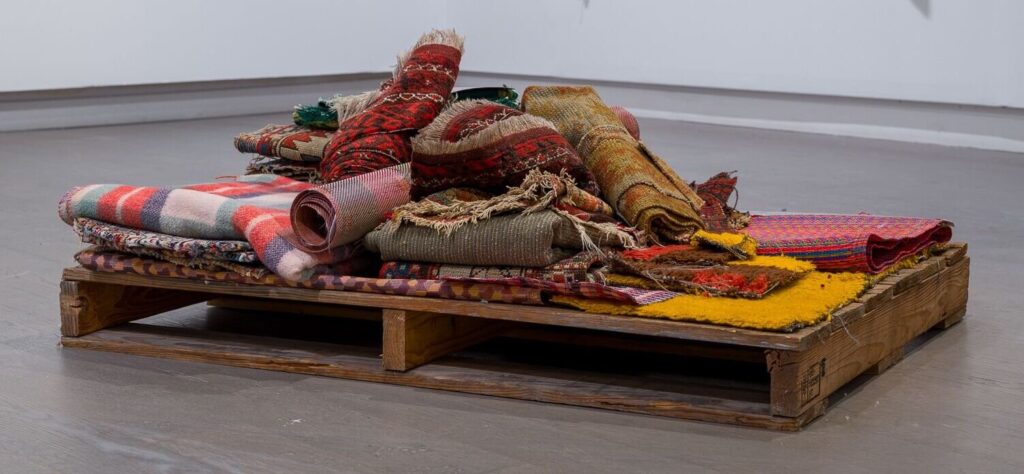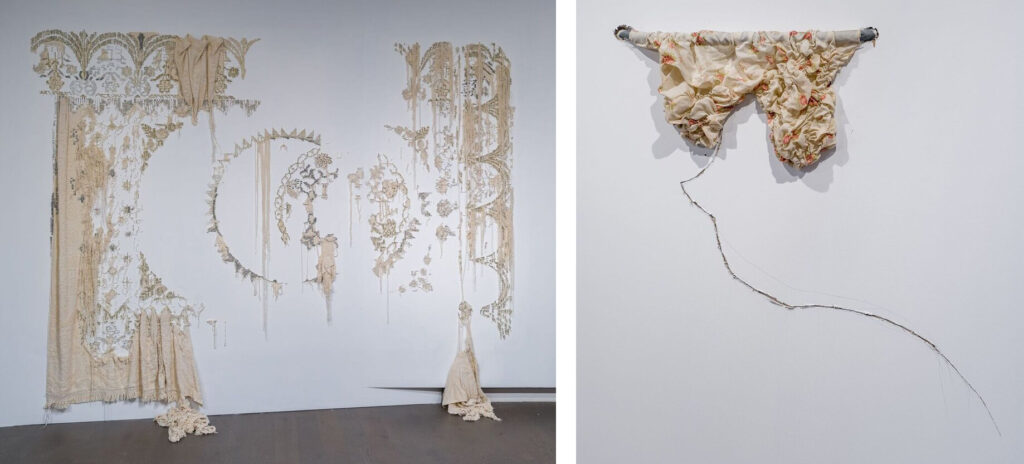Upon entering Elana Herzog’s solo exhibition, a striking installation captivates the viewer: a wall wrapped in a diverse array of fabrics, wallpapers, newspapers, and sequins, all stapled into the wall. This site-specific installation sets the tone for Herzog’s abstract works, characterized by disintegrating imagery and a destructive process, challenging traditional notions of modernist and domestic craft. Notably, most of her artworks remain untitled. Curator Jessica Stockholder observes that Herzog’s transformation from electrician to artist is reflected in her work. “We call them art ‘works,'” Stockholder notes, “because the labor-intensive process of creating art is integral to its meaning. The intersection of physical bodies with materials addresses fundamental human needs and sustains life.”
Installation view of Elana Herzog’s exhibition at Koffler Arts. Photo credit: Jeremie Warshafsky
Herzog combines familiar materials in unexpected ways to create two-and three-dimensional forms, using textiles and other domestic and building materials to make work that is raw, visceral, intimate, and tactile. Another intriguing piece, Cross Pollination, features a wood log and a curtain-like installation. Herzog worked with nylon, threading it through the ceiling in different patterns each time the piece is installed. Meredith, who assisted Herzog with the installation, revealed that the background wall color was decided spontaneously. The shadow of the nylon’s wavelike movement on the ceiling, hung through pipes, varies with each installation, adapting to the interior space and its unique characteristics.
Elana Herzog, Cross Pollination 2, 2020, cut fragments of wooden crate, miscellaneous lamber, mixed textiles sourced in Norway, Russia and New York, embroidery floss, hardware, nylon cord, 144 x 88 x 45 inches (dimensions variable). Photo credit: Jeremie Warshafsky
As a textile artist, Herzog’s use of fabric from different places is noteworthy. Her stitching intersects and alters the readymade fabrics she works with, highlighting the universal human impulse to create fabric while also honoring the unique cultural heritage embedded in each textile. Her research explores the intersection of plant life, cultural migration, and human experience. Terms like “uprooted” and “invasive” blur the lines between plants and people, revealing complex relationships between cultures and environments.
Installation view of Elana Herzog’s exhibition at Koffler Arts. Photo credit: Jeremie Warshafsky
On the floor, she displayed her collected fabrics on a pallet, alongside logs that she used as a gesture to show how trees grow, mirroring human growth and change. The logs also symbolize the connection between humans and their roots, emphasizing that even as people migrate and change, they remain connected to their cultural heritage.
Installation view of Elana Herzog’s exhibition with textile pallet at Koffler Arts. Photo credit: Jeremie Warshafsky
Herzog’s works are truly impressive and spectacular. Her art often transforms entire walls, showcasing her unique ability to turn everyday materials into extraordinary pieces. Notably, many of her works remain untitled, but one piece that stands out is the brocade bedspread material, a masterpiece featuring intricate motifs created with industrial-grade metal staples. Viewers are left wondering how such a delicate piece is installed and whether it will withstand movement. On the same wall, a pipe installation and deep scratch marks create a sense of tension, drawing the viewer’s attention. Her background as an electrician is evident in her work, where she skillfully combines technical expertise with artistic vision. In her movable panel pieces, Herzog re-inscribes selected patterns from fabrics, then deconstructs them through shredding, pulling, and cutting. The remaining fragments maintain the rectangular formats of their sources, dissolving the distinction between figure and ground in ghostly, afterimage-like forms.
Installation view of Elana Herzog’s exhibition with wall hangers at Koffler Arts. Photo credit: Jeremie Warshafsky
Ultimately, Elena Herzog’s work offers a powerful reflection on the human experience, weaving together threads of identity, culture, and resilience. Through her intricate, often unsettling creations, Herzog conveys the complexities of migration, the fragility of human connection, and the enduring power of art to express the unspoken. As a testament to the boundless potential of textile art, Herzog’s project stands as a poignant reminder of the beauty, complexity, and vulnerability that define us all.
Nusrat Papia
Images are courtesy of Koffler Arts.
*Exhibition information: Elana Herzog solo exhibition, February 13 – May 11, 2025, Koffler Arts, 180 Shaw St., Toronto. Gallery hours: Wednesday 12 – 5 pm, Thursday 12 – 8 pm, Friday – Sunday 12 – 5 pm.





